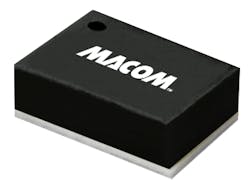MACOM MAOM-03409B 32 Gbps Linear Differential Modulator Driver IC
MACOM developed the MAOM-03409B in response to the metro market's need for pluggable modules that can enable higher-density, lower-cost systems suited for higher volume. Requirements include electrical and optical components with lower power dissipation in smaller form factors. Additionally, for shorter metro distances, 16QAM can be used to increase data rates to 200 Gbps. The MAOM-03409B, therefore, has enabled a coherent CFP2 module with data rates up to 200 Gbps.
Specifically, the MAOM-03409B is a quad-channel linear differential modulator driver designed for use with differential indium phosphide optical modulators in coherent CFP2 optical modules. Its power consumption is up to 4 Vpp linear output voltage and it is packaged in a 14x9.1-mm surface mount package, integrated with bias chokes and coupling capacitors.
Click here to return to the 2015 Lightwave Innovation Awards page

